
Discover Your Ancestors
Two critically acclaimed publications are available to family history researchers - the annual print magazine, Discover Your Ancestors, and the monthly online magazine, Discover Your Ancestors Periodical. Click here to subscribe.A walk through the history of Eel Pie Island
Nick Thorne takes a ramble through records relating to the island in the Thames

Eel Pie Island hotel until its sale in 1899 from TheGenealogist’s Image Archive
Visiting the really successful Discover Your Ancestors Family History Show – London this year allowed me a chance to explore the surrounding area before the show. It was hot that summer day and so I decided that a walk down by the River Thames on the bank opposite Twickenham would be a suitable thing to do. Within a few minutes I became aware that I was now opposite the fascinating Eel Pie Island where once had stood the hotel that had been the home of the Eel Pie Island Jazz Club. In recent history it was where just about everyone who was anyone in the British 1960s rock music field from the Rolling Stones to Rod Stewart, Eric Clapton to Pete Townshend played to audiences before they went on to achieve stardom. In the fifties it had been jazz music that attracted the audiences with the likes of George Melly, Kenny Ball and Acker Bilk. Before that in the twenties and thirties the venue had hosted tea dances in its ballroom.
The famed Eel Pie Hotel itself dated back to the 19th century and an inn, variously called The Ship in the Ait and then the White Cross and reputedly frequented by Charles Dickens, had been in business on the islet for many years. Dickens used the location in his book Nicholas Nickleby (1838-9) when his character the young Miss Morleena Kenwiggs goes to Eel Pie Island for a picnic.
Apart from its hotel, Eel Pie Island has been home to various famous residents including the first Doctor Who, William Hartnell, and the inventor Trevor Baylis, best known for his wind-up radio from the early 1990s. My own personal teenage memory is of visiting successful friends of my parents who lived on the island and commuted to their office in the West End of London. Their riverside home was one of the white 1970s houses in the Aquarius development that sits today on the site of what had been the famous former island hotel.
As I peered through the trees from the track on the other bank of the river, memories of their motor launch, moored at the bottom of their garden, came flooding back to me. Walking along the river path on the opposite side of the island, a second recollection I had was of my parents parking their car on the embankment in Twickenham to then walk over the pedestrian bridge to the house. Researching the history of the island, on my return, told me that the bridge was only put up in 1957 to link the island with Twickenham; before its construction the tiny island could only be reached by ferry.
The island itself had once been called the Twickenham Ait, or Eyot, until it became better known in the 1830s as Eel Pie Island. Its new name was acquired as a tribute to the food that the well-to-do day trippers on the river boats were able to eat at the hostelry flourishing on its shores.
Going, going – sold!
Researching in the Newspapers and Magazines Collection of records on TheGenealogist I was able to come across a couple of articles in The Illustrated London News that fascinated me, referring to the sale of the island. In the newspaper’s edition that was published on 21 January 1899 the journal reported in disappointed tones that the island had been sold on the 12th of that month to a brewery firm for the price of £4700. The new owners, so the piece disclosed, were promising a ‘new grand hotel, with gardens and boathouses and accommodation for a host of summer visitors’. The dust had hardly settled when, according to some of the other results returned by the newspaper record search, we find the island being sold once again in August of the same year!
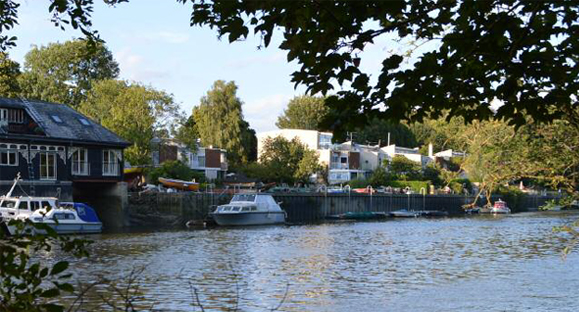
1970s houses built on the former site of Eel Pie Island Hotel photographed in 2019
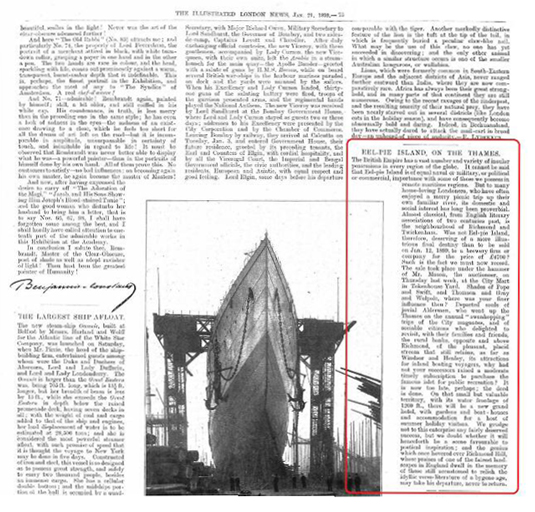
The Illustrated London News 21 January 1899 reports that it had been sold on 12 January to a brewery firm for the price of £4700
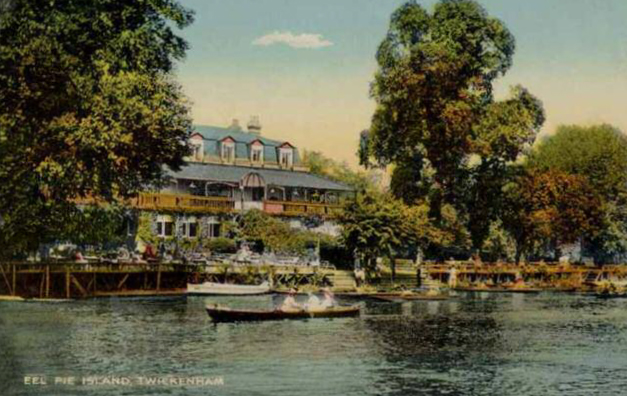
Eel Pie Island Hotel circa 1900s
The Illustrated London News of 26 August reports that ‘Eel Pie Island, at Twickenham, with the hotel upon it, was sold on August 17 at the Mart, Tokenhouse Yard. Failing a bidder for the island in one lot, it was split up into over twenty sites for builders of future bungalows, the whole property releasing something over £6000.’
From this it appears that the brewery firm made a good return on its investment in seven months and paved the way for the patchwork of small plots that make up the island today. The accompanying picture also reveals a plainer building than the one that eventually developed in the 1900s.
TheGenealogist is the home of the National Tithe Record Collection online, and by searching these particular records that were mostly created between 1837 and the 1850s we are able to find the Twickenham Ait when it was divided into far fewer plots. The date of the survey that included the island, from an examination of the apportionment books that accompany the maps in this collection, was 24 May 1845.
The tavern was marked in red on the map, but the description of the plot pinpointed on the map referred to a house and gardens. The owner at this time in 1845 is listed as Mrs Ann Fielder, while the occupier is James Mayo. From the published history we know that back in 1801 the licensee of the White Cross Inn, when it stood on the ait, had been Elizabeth Horn (or Horne) and a William Fielder. As Fielder is the surname of the landowner at the time of the tithe survey it is not much of a jump to think that Ann was related to William by marriage.

Tithe map of Eel Pie Island from the National Tithe collection on TheGenealogist
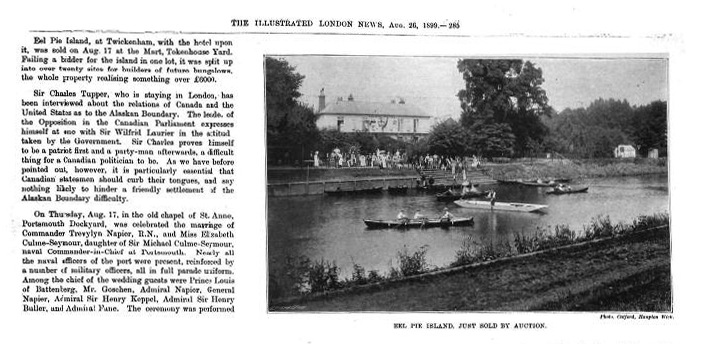
The Illustrated London News 26 August, 1899
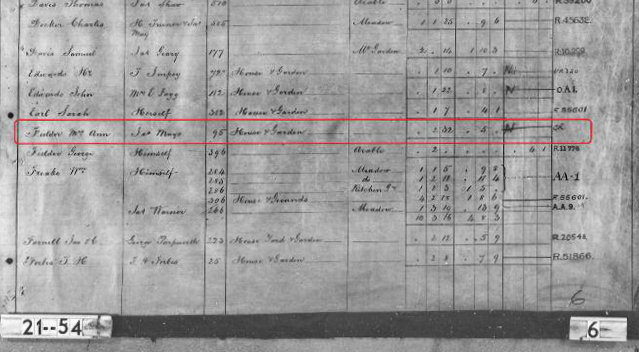
National Tithe Collection Apportionment book from TheGenealogist
The Mayo family
The occupier, James Mayo, is documented in various reports of the island’s history as being one of the family who had owned the hotel for many years. The Mayos had purchased the business in the 1830s after the old White Cross Inn had been rebuilt as a hotel on the site and remained until the 1880s.
It is thought that Henry Horn had sold the business to Thomas Mayo, who then ran it until 1841 when his son James then took over. Thomas Mayo’s death can be found in the 1841 death indexes on TheGenealogist and James himself died in December 1862, at which time the reins then passed to James’s wife Elizabeth. But from a look at the census records on TheGenealogist we can see that Elizabeth had help in the running of the hotel. The 1871 census shows that Charles R Reed is now the head of the household and the hotel keeper. From a glance at the census record it appears that he had married the Mayos’ daughter Eliza N. What is noticeable, however, is that Eliza’s 68-year-old mother, Elizabeth, also retains the same occupational title as her son-in-law, making it appear that she has not passed over all control.
Ten years earlier in the 1861 census, and when James was still alive, the Mayo’s daughter Eliza N. was as yet unmarried. To discover more I then did a search of the marriage indexes on TheGenealogist, which returned the record of the marriage in the last quarter of 1870 in the Kingston district. Their full names are given as Elizabeth Newman Mayo and Charles Robert Reed.
The 1861 census does not give the name of the hotel, referring to it as ‘Twickenham Ait’. However, a list of publicans that appear in the 1861 Post Office Trades Directories for Middlesex, digitised on TheGenealogist, shows us that the island’s hostelry was referred to as Eel Pie House. In the next year, James would be dead and Elizabeth his wife would have to take over the business until her son-in-law joined the family in 1870.
Having found that in 1871 Charles Reed and Elizabeth Mayo were both recorded as hotel keepers, it is interesting that going forward to the 1881 census another change has happened. By this time Elizabeth and Eliza are now living together at Stoneley Cottage in Twickenham – they are both widows. A search of the death records on TheGenealogist for Charles finds his death in the last quarter of 1875. It is not in the Twickenham area but is registered in the City of London. This means Eliza and Charles only had five years of marriage and interestingly 1875 had also been the year in which he had taken on the licence for the Queen Victoria Hotel in Queen Victoria Street, London. It turns out that this public house in the City was also the place of his untimely death.
While mother and daughter are now living in the town, a new hotel keeper, Andrew Anderson, and his wife Elizabeth are now listed at the island hotel.
The owners of the Eel Pie Island Hotel from this period would no doubt have been bemused by its fame in the music scene of the 1960s – and perhaps sad that there is no sign of the hotel left at all today, as can be seen by using TheGenealogist’s Map Explorer Tool.
Eel Pie Island has indeed a fascinating history. While many will know of it from its 20th century connection to sixties rock music, it turns out that even before the Eel Pie Island Hotel had stood on its bank, taverns called The Ship in the Ait and then the White Cross had drawn numerous visitors to its shores. While it no longer has a hostelry of any sort, this part of Twickenham is the home of several artists who open their studios to the public twice a year. Other than this, Twickenham Rowing Club and the boatyards, there is little to draw the casual visitor to cross the bridge. There are two nature reserves at each end of the island, but without public access and with private houses now occupying most of the islet, views of the river are non-existent from the path. This seems very different from when the historical maps on TheGenealogist were drawn up and Dickens had his character Morleena Kenwiggs visiting Eel Pie Island for her picnic.
It is intriguing to look at a place and compare its modern-day features with its historical past. The Map Explorer provides a great way of getting your ancestor's perspective on their environment and along with the various other records on TheGenealogist can add engaging depth to this sort of research.
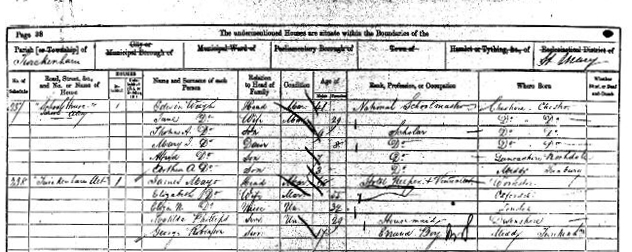
James Mayo and family in the 1861 census of Twickenham
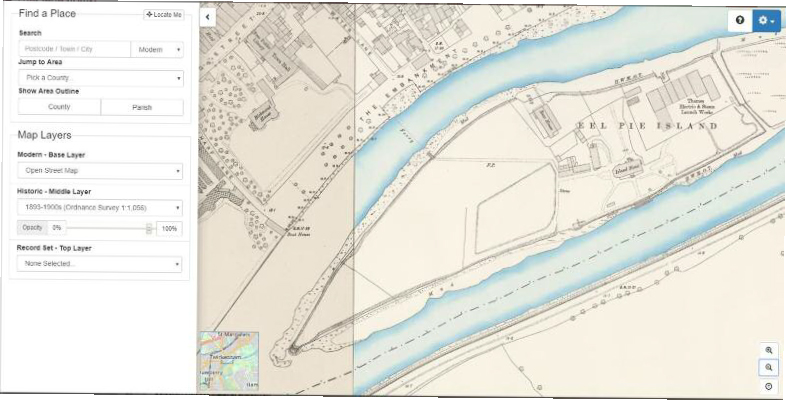
The Historical Map layer
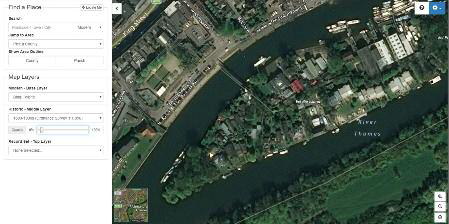
Hybrid Modern Map layer of TheGenealogist’s Map Explorer tool